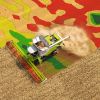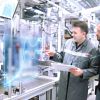Work in the fields with software
The German Fraunhofer Society is doing research in digital agriculture - and cooperating with an American industrial partner.

Software systems and artificial intelligence are becoming increasingly important on farmland, and the use of drones and cameras is also contributing to high-tech networking. The German Fraunhofer Society, Europe's largest organization for application-oriented research, is driving smart farming forwards. “Our goal is to understand the status quo of a machine’s architecture in order to derive requirements for autonomous systems and to support them in their development”, says Pablo Oliveira Antonino of the Fraunhofer Institute for Experimental Software Engineering (Fraunhofer IESE). “We’re building on both internal research and long-term cooperation with our partner John Deere.”
The American agricultural machinery manufacturer and the Fraunhofer IESE work together on numerous projects, such as software diversity, security issues and environmental protection. But other Fraunhofer institutes also cooperate with John Deere. A look at three outstanding examples.
Cooperation between man and machine
The “Tractor Implement Automation” technology developed by John Deere links tractors and attached machines such as straw balers: the combination’s steering and speed are automatically matched, depending on the amount of straw to be picked. The problem: currently John Deere has to test every possible combination of tractor and device to guarantee the safety of the system. Experts at the Fraunhofer IESE are therefore working to bring together the comprehension of a human operator with the combined equipment. If the operator can be integrated into the security concept, the time-consuming preliminary check can be omitted.
Braking quickly and automatically
Machines respond faster than humans: autonomous vehicles equipped with sensors and a camera system brake 1.1 seconds sooner than a human driver when someone suddenly appears in front of them. At a speed of 50 kilometres per hour, this still means that the vehicle continues on its way for seven metres before stopping. The Fraunhofer Institute for Reliability and Microintegration (Fraunhofer IZM) is therefore developing a camera radar module together with various partners from research and industry, including John Deere. The cell phone-sized module brakes faster than 10 milliseconds - and the mowing vehicle comes to a standstill after just 15 centimetres.
Monitoring combine harvesters
If a combine harvester suddenly stops working, it is a real nuisance for a farmer: field work falters and crop failure threatens. To prevent this, the AcoustiX sensor system at John Deere monitors combine harvesters before they leave production. AcoustiX, which was developed by scientists at the Fraunhofer Institute for Non-Destructive Testing (Fraunhofer IZFP), listens closely: if a cutting unit does not make the characteristic noises, this suggests faulty production. The human ear can in principle detect the same problem, but it tires over time and is also influenced by environmental noise. AcoustiX uses acoustic sensors that are attached directly to the machine or detect noises contact-free via microphones. Errors or irregularities are analysed automatically. Based on the signal analysis, statements about the correct function of the combine harvester can be made within only a few minutes.


